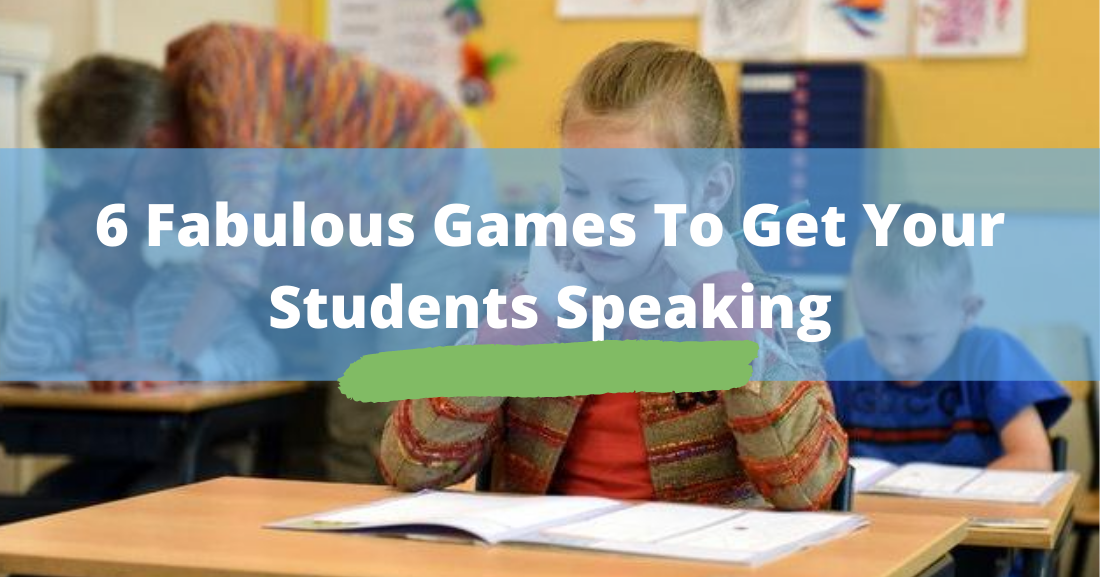Many ESL teachers find that their students are timid speakers or reluctant to participate in class discussions.

It’s only natural. After all, they are trying to talk in a language they are still working on learning. Still, silence can be deadly in the ESL classroom for your students and you. When you want to get your students to speak up, try one of these fun and simple games to get them talking in class.

Try These 6 Involving Activities for Students to Speak Up
-
1
This is How We Roll
You can use this simple game as a get to know you at the start of school or later as a get to know you better activity. All you need is one standard die and six questions – either ice breakers or ones that elicit opinions, experience or other personal thoughts. Be creative and choose the ones you’d like to hear your students answer. Give students a list of the questions, and make sure they are numbered on the paper. Then, have students take turns rolling the die. Whatever number they roll, that is the question they must answer. You could do this activity as a class, in smaller groups or as a public speaking activity. For the latter, have students prepare answers to each question as homework and then have them share in front of the class after they roll.
-
2
Human Experience Bingo
Your students are probably already familiar with the rules of Bingo. Simply get five numbers in a line on a chart. You can use this as a basis for another get to know you game. Work with your class to compile a list experiences that a person might have had. For example:
- Gone scuba diving
- Made a birthday cake
- Eaten sushi
-
These would be good experiences and work together on the list until you have about 30-40 different experiences. (You can also compile the list on your own if you prefer.) Then, give students a blank bingo board (a 5x5 chart) and have them write one experience in each of the boxes. On your word, students mingle and talk to each other to find someone with each experience they have chosen. If a student finds someone who, for example, has gone scuba diving, that student signs the square where your student wrote it on his Bingo board. The first person to get five in a row yells, “Bingo!” Another variation is to arrange students speed dating style: two rows of chairs facing each other. Each pair then gets two minutes to talk with each other. When time is up, the students in one row shift one chair to the right. The game is over once someone has gotten five spaces in a row on their bingo board.
-
3
Character Trait Roulette
This game works best for students who already know each other fairly well. Work as a group to come up with a list of several character traits a person might have. (Try to stick to positive traits.) You might include adventurous, sympathetic and generous. Then write these traits on small slips of paper and put them in a bag. Each person takes a turn drawing one character trait from the bag in front of the class. The student must then announce who in class (and you are fair game, too) possesses that character trait. Of course, a name isn’t enough. The person must tell a story or give an example of why he made his particular choice.
-

-
4
Story Starter Hot Potato
Put the list of story starters in your writing drawer to double duty with this silly and fast paced game. Students play in small groups of around five members. Students should arrange their seats in a circle. Give your class a story starter at the beginning of the round. Starting with the person whose birthday is closest to today and them moving around the circle, each person gives his group one sentence of the story. After one person is done, the person sitting to his left adds a line where the first person left off. Students continue around the circle, adding one sentence at a time, until the music stops or until you give another signal. Whoever is in the middle of his sentence or is struggling to think of a sentence when the music stops is out. He must leave the circle. Then students play a second round either continuing the story or with a new story starter. When you stop the music, whoever’s turn it is is eliminated. Play continues until the final round when the person not speaking when the music stops is the winner.
-
5
Find Your Partner
Prepare a small slip of paper for each student in your class. Each paper should have one word on it that goes with a word on another slip of paper. For example matching pairs might be:
- Fork and spoon
- Day and night
- Bat and ball
- Table and chairs
-
6
Hide and Speak
To prepare for this energetic and fast paced game, write several questions each on one index card or post-it note. These questions can be get to know you questions, comprehension questions or questions using current vocabulary words. Before your students arrive, hide these cards throughout your classroom. At the start of class, break your students into two teams. Explain that you have hidden cards throughout the room. On your word, students will search the room for the cards you have hidden. They can only pick up one card at a time. When a student finds a card, he must bring it to you and answer the question on the card. If he answers it correctly, he earns the card for his team. If he does not answer it correctly, he must get someone else from his team to help him find the answer. Once students have correctly answered the question on their card, they can search for another card. At the end of the game (after a certain amount of time or when all the cards have been found) the team with the most cards in their possession wins.
Speaking doesn’t have to be forced or boring when it comes to ESL class. These games are just a few of the fun ways to get your students speaking up and having a good time while they practice their English.
P.S. If you enjoyed this article, please help spread it by clicking one of those sharing buttons below. And if you are interested in more, you should follow our Facebook page where we share more about creative, non-boring ways to teach English.






